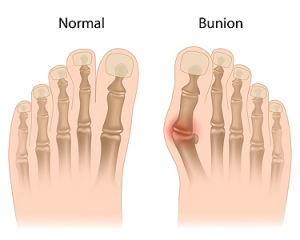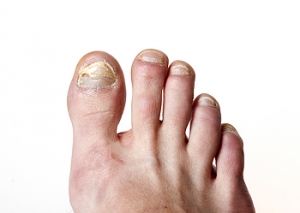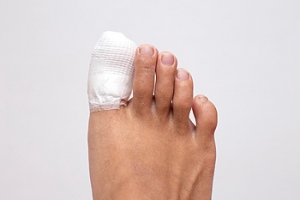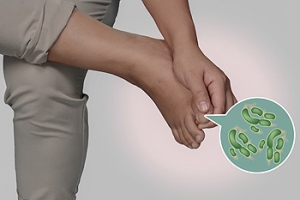Featured Articles

Treatment Options For Bunion
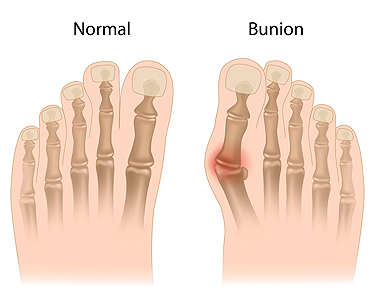 The medical condition known as hallux valgus is commonly referred to as a bunion. It typically occurs as a result of a misalignment in the joint of the big toe, and may cause pain and discomfort. It appears as a large bony protrusion on the side of the big toe and may be difficult to wear specific shoes. If you have a bunion, you most likely may notice tenderness and swelling around the affected joint, in addition to possible joint pain arising from the development of arthritis. This may develop at a faster rate if the bunion is not treated promptly. Some of the reasons why bunions could form may include having an abnormal foot structure such as flat feet, an inherited genetic trait, or extremely flexible ligaments and tendons. Research has shown there are different treatment techniques, which may provide moderate relief. This includes wearing shoes that fit correctly, performing gentle exercises, or wearing insoles in the shoes. It’s important to consult with a podiatrist who can determine the best treatment option for you.
The medical condition known as hallux valgus is commonly referred to as a bunion. It typically occurs as a result of a misalignment in the joint of the big toe, and may cause pain and discomfort. It appears as a large bony protrusion on the side of the big toe and may be difficult to wear specific shoes. If you have a bunion, you most likely may notice tenderness and swelling around the affected joint, in addition to possible joint pain arising from the development of arthritis. This may develop at a faster rate if the bunion is not treated promptly. Some of the reasons why bunions could form may include having an abnormal foot structure such as flat feet, an inherited genetic trait, or extremely flexible ligaments and tendons. Research has shown there are different treatment techniques, which may provide moderate relief. This includes wearing shoes that fit correctly, performing gentle exercises, or wearing insoles in the shoes. It’s important to consult with a podiatrist who can determine the best treatment option for you.
If you are suffering from bunions, contact one of our podiatrists of Romeo Foot & Ankle Clinic. Our doctors can provide the care you need to keep you pain-free and on your feet.
What Is a Bunion?
A bunion is formed of swollen tissue or an enlargement of boney growth, usually located at the base joint of the toe that connects to the foot. The swelling occurs due to the bones in the big toe shifting inward, which impacts the other toes of the foot. This causes the area around the base of the big toe to become inflamed and painful.
Why Do Bunions Form?
Genetics – Susceptibility to bunions are often hereditary
Stress on the feet – Poorly fitted and uncomfortable footwear that places stress on feet, such as heels, can worsen existing bunions
How Are Bunions Diagnosed?
Doctors often perform two tests – blood tests and x-rays – when trying to diagnose bunions, especially in the early stages of development. Blood tests help determine if the foot pain is being caused by something else, such as arthritis, while x-rays provide a clear picture of your bone structure to your doctor.
How Are Bunions Treated?
- Refrain from wearing heels or similar shoes that cause discomfort
- Select wider shoes that can provide more comfort and reduce pain
- Anti-inflammatory and pain management drugs
- Orthotics or foot inserts
- Surgery
If you have any questions, please feel free to contact our offices located in Washington and Shelby Townships, MI . We offer the newest diagnostic and treatment technologies for all your foot care needs.
What Are Bunions?
Bunions are large bony bumps at the base of the big toe. Medically known as hallux valgus, a bunion is a misalignment of the metatarsophalangeal joint, or big toe joint. The misalignment will generally worsen with time if left untreated.
The exact cause of bunions is unknown, with genetics seen as a potential cause. High heels and poorly-fitted footwear, rheumatoid arthritis, and heredity all seem to be potential factors behind the exacerbation of bunions. Women have been found to be more likely to develop bunions in comparison to men.
Bunions do not always produce symptoms. The best way to tell is if the big toe is pushing up against the next toe and there is a large protrusion at the base of the big toe. You may or may not feel pain. Redness, swelling, and restricted movement of the big toe may be present as well.
Podiatrists use a variety of methods to diagnose bunions. If there are symptoms present, podiatrists will first consider that it is a bunion. If not, a physical examination will be conducted to check function of the big toe. Finally, an X-ray may be taken to view the extent of the bunion and confirm it is a bunion.
Typically, nonsurgical methods are used to treat bunions, unless the bunion has become too misaligned. Orthotics, icing and resting the foot, roomier and better fitted shoes, taping the foot, and pain medication are usually utilized first. If the bunion doesn’t go away or causes extreme pain, surgery may be required. Surgeons will either remove part of the swollen tissue or bone to straighten the toe out.
If you have a bunion, it is recommended to see a podiatrist. The longer it is left untreated, the worse it may get. Podiatrists can properly diagnose and treat a bunion before it gets worse.
Is There A Link Between Obesity and Toenail Fungus?
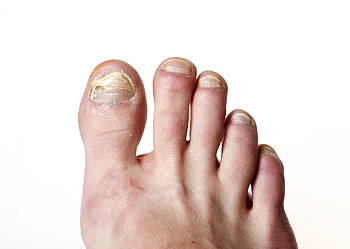 Researchers in Korea have found that excessive weight gain may lead to the unsightly condition known as onychomycosis, which is also referred to as toenail fungus. In patients who are diabetic, this condition may be painful and may lead to the development of additional infections. It may be beneficial to treat this ailment as early as possible and this may be accomplished by using a topical medicine. In more advanced cases, injections may be necessary to administer around the nail bed. Toenail fungus is typically not life-threatening, and there may be moderate symptoms that may accompany this condition. The most noticeable signs may be a thickening of the toenail, and may often appear black in color as the infection progresses. If you feel you have this condition, it’s advised to consult with a podiatrist who can recommend the best course of treatment for you.
Researchers in Korea have found that excessive weight gain may lead to the unsightly condition known as onychomycosis, which is also referred to as toenail fungus. In patients who are diabetic, this condition may be painful and may lead to the development of additional infections. It may be beneficial to treat this ailment as early as possible and this may be accomplished by using a topical medicine. In more advanced cases, injections may be necessary to administer around the nail bed. Toenail fungus is typically not life-threatening, and there may be moderate symptoms that may accompany this condition. The most noticeable signs may be a thickening of the toenail, and may often appear black in color as the infection progresses. If you feel you have this condition, it’s advised to consult with a podiatrist who can recommend the best course of treatment for you.
For more information about treatment, contact one of our podiatrists of Romeo Foot & Ankle Clinic. Our doctors can provide the care you need to keep you pain-free and on your feet.
Toenail Fungus Treatment
Toenail fungus is a condition that affects many people and can be especially hard to get rid of. Fortunately, there are several methods to go about treating and avoiding it.
Antifungals & Deterrence
Oral antifungal medicine has been shown to be effective in many cases. It is important to consult with a podiatrist to determine the proper regiment for you, or potentially explore other options.
Applying foot powder on the feet and shoes helps keep the feet free of moisture and sweat.
Sandals or open toed shoes – Wearing these will allow air movement and help keep feet dry. They also expose your feet to light, which fungus cannot tolerate. Socks with moisture wicking material also help as well.
If you have any questions please feel free to contact our offices located in Washington and Shelby Townships, MI . We offer the newest diagnostic tools and technology to treat your foot and ankle needs.
Toenail Fungus
Toenail fungus is a frustrating problem that affects many people. It can be persistent and hard to get rid of. As many different types of fungi are present throughout the environment, it is very easy to contract toenail fungus.
The feet are especially susceptible to toenail fungus because shoes and socks create the ideal dark and moist environment that fungal infections thrive in. While fungal infections of the nail plate are quite common, if left untreated they can spread beyond the toenail and into the skin and other parts of the body.
Signs of toenail fungus include a thickened nail that has become yellow or brown in color, a foul smell, and debris beneath the nail. The toe may become painful due to the pressure of a thicker nail or the buildup of debris.
Treatment for toenail fungus is most effective during the early stages of an infection. If there is an accumulation of debris beneath the nail plate, an ingrown nail or a more serious infection can occur. While each treatment varies between patients, your podiatrist may prescribe you oral medications, topical liquids and creams, or laser therapy. To determine the best treatment process for you, be sure to visit your podiatrist at the first signs of toenail fungus.
The Differences Between a Sprained Toe and a Broken Toe
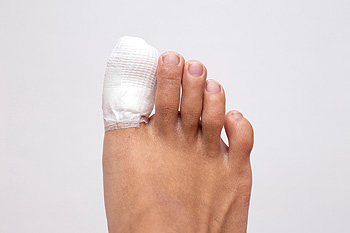 Many people mistake a stubbed toe with a broken toe. This may be a common error because they both produce considerable pain and discomfort. If a toe is broken, it’s important to obtain proper treatment as quickly as possible. If the toe is left untreated, it may affect walking and running ability in addition to experiencing chronic pain. There is known to be a few differences between a broken toe and a sprained toe. These may include bruising, pain in the exact area of the break, or a possible dislocation, which may accompany a fractured toe. A sprained toe may have more generalized pain in the surrounding area where the injury has occurred, although there may be considerable bruising. If you feel you have broken or sprained your toe, it may be beneficial to seek the counsel of a podiatrist to obtain a correct diagnosis and offer the best course of treatment.
Many people mistake a stubbed toe with a broken toe. This may be a common error because they both produce considerable pain and discomfort. If a toe is broken, it’s important to obtain proper treatment as quickly as possible. If the toe is left untreated, it may affect walking and running ability in addition to experiencing chronic pain. There is known to be a few differences between a broken toe and a sprained toe. These may include bruising, pain in the exact area of the break, or a possible dislocation, which may accompany a fractured toe. A sprained toe may have more generalized pain in the surrounding area where the injury has occurred, although there may be considerable bruising. If you feel you have broken or sprained your toe, it may be beneficial to seek the counsel of a podiatrist to obtain a correct diagnosis and offer the best course of treatment.
Broken toes may cause a lot of pain and should be treated as soon as possible. If you have any concerns about your feet, contact one of our podiatrists from Romeo Foot & Ankle Clinic. Our doctors will treat your foot and ankle needs.
What Is a Broken Toe?
A broken toe occurs when one or more of the toe bones of the foot are broken after an injury. Injuries such as stubbing your toe or dropping a heavy object on it may cause a toe fracture.
Symptoms of a Broken Toe
- Swelling
- Pain (with/without wearing shoes)
- Stiffness
- Nail Injury
Although the injured toe should be monitored daily, it is especially important to have a podiatrist look at your toe if you have severe symptoms. Some of these symptoms include worsening or new pain that is not relieved with medication, sores, redness, or open wounds near the toe.
If you have any questions, please feel free to contact our offices located in Washington and Shelby Townships, MI . We offer the newest diagnostic and treatment technologies for all your foot care needs.
What to Know About a Broken Toe
The forefoot is composed of five metatarsal bones and fourteen phalanges. Each toe has three phalanges except for the big toe which only has two. Our toes play an essential role to the walking process, which is why a broken toe could seriously disrupt one’s ability to move around. Toe fractures are common and can be very painful. Fortunately, these injuries rarely require surgery and usually heal with rest and a change in activity.
Broken toes typically result from a traumatic event such as falling, stubbing the toe, or dropping something on the toe. Traumatic toe fractures may be categorized as either minor or severe fractures. At times, one may hear a “pop” or “crack” sound when the bone breaks. Common symptoms of a traumatic toe fracture include pain, throbbing, bruising, swelling, and redness.
Another type of toe fractures is a stress fracture. These injuries usually appear in the form of small hairline breaks on the bone. Stress fractures develop after repetitive activity instead of a single injury. Stress fractures occur when the muscles in the bone become too weak to absorb impact. Consequently, the toe bone becomes vulnerable to any pressure and impact it endures. Symptoms for a stress fracture in the toe include swelling without bruising, tenderness to the touch, pain that goes away with rest, and pain after walking or running.
If you suspect that you have a broken toe, you should make an appointment with your podiatrist. He or she will likely diagnose you by performing a physical exam and an X-ray. Treatment for a broken toe may include the R.I.C.E. method, buddy taping, surgery, or antibiotics. The R.I.C.E. method (Rest, Ice, Compression, and Elevation) is a common treatment method for many injuries because it decreases pain. Buddy tapping involves wrapping the injured toe next to an adjacent toe to keep it supported and protected. These two methods have proven to be effective in the healing process for toe fractures. The estimated healing time for a broken toe is approximately four to six weeks. If the injury becomes infected or requires surgery, the estimated healing time may take eight weeks or more.
Children Who Are Prone to Develop Sever’s Disease
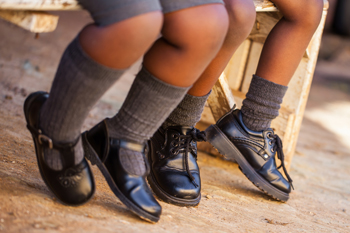 If your physically active child complains of heel pain, it may be a result of a condition referred as Sever’s disease. It is generally caused by excessive strain put on the growth plate of the heel, and typically affects children who are young adolescents. There are several symptoms that may be associated with Sever’s disease, including swollen heels, difficulty while walking, and tenderness in the foot and heel. The child may experience general pain and discomfort and it’s suggested to cease the activity that caused this condition while the healing takes places. Despite the fact that this ailment may be prevalent in physically active children, research has shown there may be additional factors in the development of Sever’s disease. These may include wearing shoes that do not fit correctly, obesity, or having flat or high arches. If you feel your child may have this affliction, please schedule a consultation with a podiatrist who will determine the best course of treatment as quickly as possible.
If your physically active child complains of heel pain, it may be a result of a condition referred as Sever’s disease. It is generally caused by excessive strain put on the growth plate of the heel, and typically affects children who are young adolescents. There are several symptoms that may be associated with Sever’s disease, including swollen heels, difficulty while walking, and tenderness in the foot and heel. The child may experience general pain and discomfort and it’s suggested to cease the activity that caused this condition while the healing takes places. Despite the fact that this ailment may be prevalent in physically active children, research has shown there may be additional factors in the development of Sever’s disease. These may include wearing shoes that do not fit correctly, obesity, or having flat or high arches. If you feel your child may have this affliction, please schedule a consultation with a podiatrist who will determine the best course of treatment as quickly as possible.
Sever's disease often occurs in children and teens. If your child is experiencing foot or ankle pain, see one of our podiatrists from Romeo Foot & Ankle Clinic. Our doctors can treat your child’s foot and ankle needs.
Sever’s Disease
Sever’s disease is also known as calcaneal apophysitis, which is a medical condition that causes heel pain I none or both feet. The disease is known to affect children between the ages of 8 and 14.
Sever’s disease occurs when part of the child’s heel known as the growth plate (calcaneal epiphysis) is attached to the Achilles tendon. This area can suffer injury when the muscles and tendons of the growing foot do not keep pace with bone growth. Therefore, the constant pain which one experiences at the back of the heel will make the child unable to put any weight on the heel. The child is then forced to walk on their toes.
Symptoms
Acute pain – Pain associated with Sever’s disease is usually felt in the heel when the child engages in physical activity such as walking, jumping and or running.
Highly active – Children who are very active are among the most susceptible in experiencing Sever’s disease, because of the stress and tension placed on their feet.
If you have any questions, please feel free to contact our offices located in Washington and Shelby Townships, MI . We offer the newest diagnostic and treatment technologies for all your foot and ankle injuries.
Sever's Disease
Sever's disease, also known as calcaneal apophysitis, is a medical condition that causes heel pain in children’s feet while they’re growing. Sever's disease occurs most commonly in boys and girls between the ages of 8 and 14.
Sever's disease occurs when the child’s growth plate, or the calcaneal epiphysis, an area attached to the Achilles tendon, is injured or when the muscles and tendons of the growing foot do not keep pace with bone growth. The result is constant pain experienced at the back of the heel and the inability to put any weight on the heel. This forces the child to bear weight on their toes while walking. When a toe gait develops, the child must change the way they walk to avoid placing weight on the painful heel. If this is not properly addressed, this can lead to further developmental problems.
The most common symptom of Sever's disease is acute pain felt in the heel when a child engages in physical activity such as walking, jumping or running. Children who are active athletes are among the group most susceptible to experiencing Sever's disease. This is due to the extreme stress and tension placed on their growing feet. The rolling movement of the foot during walking or running and obesity are both additional conditions linked to causing Sever's disease.
The first step in treating Sever's disease is to rest the foot and leg and avoid physical activity. Over the counter pain-relieving and anti-inflammatory medications can be helpful for reducing the amount of heel pain. A child with Sever's disease should also wear shoes that properly support the heel and the arch of the foot. Consider purchasing orthotic shoe inserts which can help support the heel and foot while it is healing. Most patients with Sever's disease symptoms report an eventual elimination of heel pain after wearing orthotic insoles that support the affected heel.
Sever's disease may affect either one heel or both. It is important for a child experiencing heel pain to be examined by a foot doctor who can apply the squeeze test. The squeeze test compresses both sides of the heel in order to determine if there is intense pain. Discourage any child diagnosed with Sever's disease from going barefoot as this can intensify the problem. Apply ice packs to the affected painful heel two or three times a day for pain relief.
Exercises that help stretch the calf muscles and hamstrings are effective at treating Sever's disease. An exercise known as foot curling has also proven to be very effective at treating Sever's disease. When foot curling, the foot is pointed away from the body, then curled toward the body to help stretch the muscles. The curling exercise should be done in sets of 10 or 20 repetitions and repeated several times throughout the day.
Treatment methods can continue for at least 2 weeks and as long as 2 months before the heel pain completely disappears. A child can continue doing daily stretching exercises for the legs and feet to prevent Sever’s disease from returning.
Causes of Athlete’s Foot
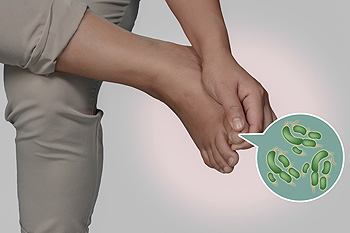 The uncomfortable condition that is known as athlete’s foot may typically have noticeable symptoms, which may include red and itchy skin. This may develop in between the toes or on the sole of the foot and is known to be a common fungal infection. This contagious foot ailment can be spread by direct contact with another person or from walking on wet floors, including shower and pool areas. There may be several preventative measures that can be practiced, which may avoid the onset of athlete’s foot. These may include washing and drying the feet thoroughly, changing socks promptly if they become wet, and wearing shoes that are made of breathable materials. If you feel you have contracted athlete’s foot, it’s advised to consult with a podiatrist who can suggest the best course of treatment that will provide relief.
The uncomfortable condition that is known as athlete’s foot may typically have noticeable symptoms, which may include red and itchy skin. This may develop in between the toes or on the sole of the foot and is known to be a common fungal infection. This contagious foot ailment can be spread by direct contact with another person or from walking on wet floors, including shower and pool areas. There may be several preventative measures that can be practiced, which may avoid the onset of athlete’s foot. These may include washing and drying the feet thoroughly, changing socks promptly if they become wet, and wearing shoes that are made of breathable materials. If you feel you have contracted athlete’s foot, it’s advised to consult with a podiatrist who can suggest the best course of treatment that will provide relief.
Athlete’s foot is an inconvenient condition that can be easily reduced with the proper treatment. If you have any concerns about your feet and ankles, contact one of our podiatrists from Romeo Foot & Ankle Clinic. Our doctors will treat your foot and ankle needs.
Athlete’s Foot: The Sole Story
Athlete's foot, also known as tinea pedis, can be an extremely contagious foot infection. It is commonly contracted in public changing areas and bathrooms, dormitory style living quarters, around locker rooms and public swimming pools, or anywhere your feet often come into contact with other people.
Solutions to Combat Athlete’s Foot
- Hydrate your feet by using lotion
- Exfoliate
- Buff off nails
- Use of anti-fungal products
- Examine your feet and visit your doctor if any suspicious blisters or cuts develop
Athlete’s foot can cause many irritating symptoms such as dry and flaking skin, itching, and redness. Some more severe symptoms can include bleeding and cracked skin, intense itching and burning, and even pain when walking. In the worst cases, Athlete’s foot can cause blistering as well. Speak to your podiatrist for a better understanding of the different causes of Athlete’s foot, as well as help in determining which treatment options are best for you.
If you have any questions please feel free to contact our offices located in Washington and Shelby Townships, MI . We offer the newest diagnostic and treatment technologies for all your foot and ankle needs.
